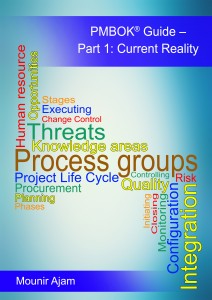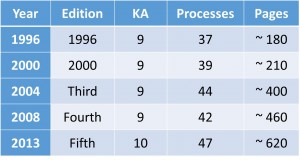In this blog post we present a chapter from a 2-book series (e-books) that we are working on, PMBOK® Guide – Part 1 – Current Reality. This post focus on the historical perspective.
 Introduction
Introduction
The historical details are not core to the purpose of this e-book. However, it would be useful to touch on certain aspects and the nature of the changes to date. The topics that we address would be relevant to understanding the overall context and the need to improving the PMBOK® Guide.
History of the guide
1996
The first official consolidated copy of the guide was published in 1996.
- It was about 180 pages,
- It had 37 processes, nine knowledge areas, and five process groups.
This first edition was not labeled as an ANSI standard.
2000
Next, the 2000 Edition was published. With this edition,
- The number of processes has changed to 39,
- The number of pages increased to about 210,
- The two additional processes were in the risk knowledge area, and
- With this edition, there were some changes to the names of the processes.
This second edition was still not labeled as an ANSI standard.
Third edition
With the 2004 edition,
- PMI started to number the editions and calling this version the Third Edition instead of the 2004 edition.
- Chapter 3 was split from the first section of the book and listed on its own under the title ‘The Standard for Project Management of a Project’. This change was likely due to ANSI approval.
- Although this edition was labeled as an ANSI standard, to our knowledge, only part of Chapter 3 was ‘the ANSI standard’ and not the whole chapter, nor the whole
- Other changes in this edition were the increase in the number of processes from 39 to 44. Most of them were in the integration chapter with the addition of four processes.
- Further, some processes moved from one knowledge area to
- The number of pages reached 400 pages.
Fourth edition
With this edition,
- There were no changes to the sections or knowledge areas,
- The number of processes dropped to 42 by consolidating the six procurement processes into four,
- There were other changes in the names of processes and movement from one knowledge area or process groups to another, and
- Some processes were also dropped, and other added.
Fifth edition
The fifth edition is the current edition[1].
- With this edition, the number of pages jumped to more than 600,
- A new knowledge area was added, and
- The number of processes increased from 42 to 47.
The above changes appears substantial but they were not significant. Our opinion is that most of the content of the additional processes were there before, incorporated into other processes. For example, the management plan processes for scope, time, and cost were part of the project management plan process in the integration chapter but with this edition they become independent processes, each in its respective knowledge area[3]. This change resulted in three of the five additional processes but it was mostly relocating the action from one place to another.
This table summarizes the general changes. Once again, there were other changes, such as the one we discussed here and other changes within the chapter that we have not discussed.
Core and facilitating processes
The first two editions split the processes in three of the process groups (planning, executing, and controlling) into core processes and facilitating processes. Initiating and closing groups do not have more than two processes each, so a split was not logical.
The core processes were related to integration, scope, time, and cost and the facilitating processes the other knowledge areas. The split was interesting and related to the concepts of the triple constraints of time, cost, and scope.
Summary and closing remarks
Except the stakeholder chapter addition in the latest edition, there have been no major structural changes to the guide. Yes, the number of processes increased and decreased, other processes changed names or location and even added content here and there. Certain things were deemphasized in the third and fourth editions but reemphasized in the fifth, like project life cycle. Further, the introduction of new standard documents by PMI[4] have resulted in additional content, mostly in Chapter 2, but also some terminology changes in other sections.
A significant change to highlight here was the guide (or part of the guide) becoming an official ANSI standard with the third edition.
Finally,
From numerous online discussions, some practitioners considers the PMBOK® Guide as the holy book, while others think it needs improvement for better understanding, and a few prefer to dismiss it. This e-book is our humble approach to offers suggestions for transforming the guide into an efficient resource for applying project management. Our attempt is to counter the common conventional view that it is NOT real life and it is not practical.
Whether PMI and PMBOK® Guide’s volunteers consider our work or not, is not our decision or within our circle of influence. What we control is sharing our thoughts and reviews with the professional community. Further, whether the information presented in these two e-books are incorporated into the PMBOK® Guide or not, we are using these concepts in our workshops, methodology, organizational project management systems, and is what we suggest to our clients.
[1] At the time of writing this book; September-October 2015.
[2] Knowledge Areas
[3] Refer to this blog article by the author on the changes from 4th to 5th editions http://blog.sukad.com/20130716/are-the-changes-from-pmbok-4-to-pmbok-5-significant/.
[4] Like program and portfolio management standards

Mounir, a few facts to consider which may influence your ebooks:
– ANSI is not in the habit of partially approving documents. The entire PMBOK(r) Guide is an ANSI approved/accredited document. You can purchase a PMBOK(r) Guide from the ANSI store as well as PMI. Proof of accreditation! Only 5th edition is available now, but 4th was available at one time from both.
– To maintain ANSI accreditation, standards need to be revised every 4-5 years. So my expectation is we will continue to see PMBOK(r) Guide revisions at regular intervals. In fact, the 6th Edition is already in progress.
– I may be wrong, but I believe the PMBOK(r) Guide 3rd Edition was an important contribution to ISO 21500 in 2012 – so many of the practices described in the PMBOK(r) Guide are now ISO standard as well.
– The PMBOK(r) Guide is a permissive standard. It is a loose framework and a collection of good and best practices. It is very flexible. There are no “thou shalts”. Contrast this with prescriptive standards like PRINCE2.
– As a permissive standard, it tells you much about the “what”, but not the “how”. So viewing it as the “holy book” doesn’t make sense – there are too many gaps. For example, it tells us that Earned Value Management is good, tells us a little bit about it, but doesn’t give us a clue as to how to implement Earned Value Management – we have to go to other sources for that. But most important of all, it doesn’t tell us “thou shalt use Earned Value Management”. That is left up to the expert judgment of the practitioner.
– The PMBOK (r) Guide is not specific as to industries. The best practices in it can be applied to all. I regularly point out to my students how practices thought to be construction specific can be applied to software development and vice versa. This goes for Life/Biological Sciences disciplines as well.
– PMI has conducted an extensive role delineation study to determine the differences between project, program, and portfolio managers. That is influencing the current PMP(r) exam and will undoubtedly create more changes to standards going forward.
– Since poor requirements have long been determined to be the #2 issue in projects (after project sponsorship/user involvement), PMI is now getting into the BA role. I expect this will bring more changes. There is no BA standard yet, only a practice guide. I’m guessing this may change over time.
Reply 2:
(1) ANSI Standard: answered in the other message
(2) “The PMBOK(r) Guide is a
permissive standard. It is a loose framework and a collection of good
and best practices.” Agree in general, except on the point of the best practices. Yes the guide is marketed as a best practice however, i tried hard to find in the guide any reference that the guide offer best practices and could not find any. The definition is clear that it is a “good practice”.
(3) “It is very flexible … As a
permissive standard, it tells you much about the “what”, but not the
“how”.”
Agree with you … although I believe this needs improvement.
(4) “So viewing it as the “holy book” doesn’t make sense – there are
too many gaps.”
Totally agree – however, the reality of the market place in many regions of the world and due to marketing – it is treated like it is the “holy book” and PMI as the only authority on project management. That is one of the main reason why I am writing my e-books.
(5) I agree with your example on EVM and the same applies to all other topics. I am already addressing all of these points in the e-books.
(6) “The PMBOK (r) Guide is not specific
as to industries.”
Once again we are in agreement.
(7) “… poor requirements have
long been determined to be the #2 issue in projects (after project
sponsorship/user involvement), PMI is now getting into the BA role.”
Here we have differences of opinion. I think PMI got it wrong by focusing on BA for many reasons. One of the main issues with “PMBOK(r) Guide followers” is the lack of visualizing a project life cycle and how the process groups repeat in every phase. If they do this then we end up with the PM Processes repeating with the PLC functioning as product development process with emphasis on the progressive elaboration of the project and product scope. By going toward BA, PMI is focusing on the wrong side and to me this is a commercial decision more than a PM Benefits decision.
(8) ” There is no BA standard yet’ … in PMI. To my knowledge there is another organization with mature standards and certifications for BA but instead of PMI referring to it – PMI chose to get “into the business”
Best Regards and Thanks
Hello Ray
Thank you very much for the detailed response.
I will post my response to your points:
ANSI
A few years back we did call ANSI to try to verify if the whole guide is a standard or only a section and we could not get an answer. So we have to depend on the guide itself. Here are two quotations from the 4th and 5th edition:
4th Ed: “Chapter 3 is the standard for project management.”
Notice that it says Chapter 3 is the standard not the guide.
5th Ed: “The PMBOK® Guide contains the standard for managing most projects most of the time across many types of industries. The standard, included in Annex A1, describes the project management processes
used to manage a project toward a more successful outcome.”
Here also notice the words “… Guide contains …” does say “… Guide is …” Then it continues to say “the standard included in Annex A1”
Other than this point, I agree that due to ANSI the guide has to be revised. I am also aware that PMI worked hard to get many concepts into ISO 21500. However, ISO 21500 also includes info from PRINCE2 and IPMA. Then the guide was influenced by ISO by adding the Stakeholder chapter into the 5th edition.